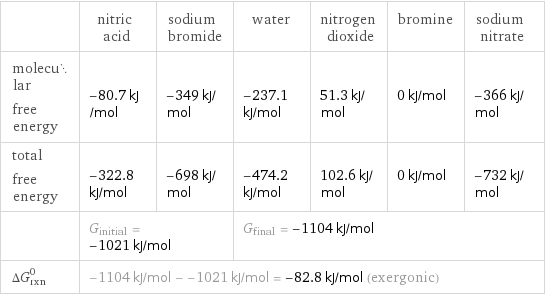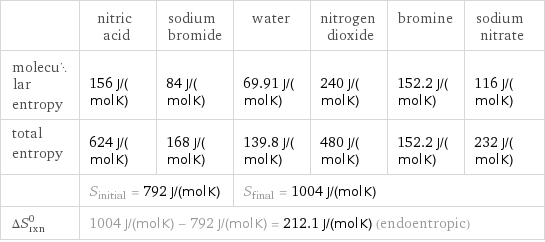Input interpretation

HNO_3 nitric acid + NaBr sodium bromide ⟶ H_2O water + NO_2 nitrogen dioxide + Br_2 bromine + NaNO_3 sodium nitrate
Balanced equation

Balance the chemical equation algebraically: HNO_3 + NaBr ⟶ H_2O + NO_2 + Br_2 + NaNO_3 Add stoichiometric coefficients, c_i, to the reactants and products: c_1 HNO_3 + c_2 NaBr ⟶ c_3 H_2O + c_4 NO_2 + c_5 Br_2 + c_6 NaNO_3 Set the number of atoms in the reactants equal to the number of atoms in the products for H, N, O, Br and Na: H: | c_1 = 2 c_3 N: | c_1 = c_4 + c_6 O: | 3 c_1 = c_3 + 2 c_4 + 3 c_6 Br: | c_2 = 2 c_5 Na: | c_2 = c_6 Since the coefficients are relative quantities and underdetermined, choose a coefficient to set arbitrarily. To keep the coefficients small, the arbitrary value is ordinarily one. For instance, set c_5 = 1 and solve the system of equations for the remaining coefficients: c_1 = 4 c_2 = 2 c_3 = 2 c_4 = 2 c_5 = 1 c_6 = 2 Substitute the coefficients into the chemical reaction to obtain the balanced equation: Answer: | | 4 HNO_3 + 2 NaBr ⟶ 2 H_2O + 2 NO_2 + Br_2 + 2 NaNO_3
Structures

+ ⟶ + + +
Names

nitric acid + sodium bromide ⟶ water + nitrogen dioxide + bromine + sodium nitrate
Reaction thermodynamics
Gibbs free energy

| nitric acid | sodium bromide | water | nitrogen dioxide | bromine | sodium nitrate molecular free energy | -80.7 kJ/mol | -349 kJ/mol | -237.1 kJ/mol | 51.3 kJ/mol | 0 kJ/mol | -366 kJ/mol total free energy | -322.8 kJ/mol | -698 kJ/mol | -474.2 kJ/mol | 102.6 kJ/mol | 0 kJ/mol | -732 kJ/mol | G_initial = -1021 kJ/mol | | G_final = -1104 kJ/mol | | | ΔG_rxn^0 | -1104 kJ/mol - -1021 kJ/mol = -82.8 kJ/mol (exergonic) | | | | |
Entropy

| nitric acid | sodium bromide | water | nitrogen dioxide | bromine | sodium nitrate molecular entropy | 156 J/(mol K) | 84 J/(mol K) | 69.91 J/(mol K) | 240 J/(mol K) | 152.2 J/(mol K) | 116 J/(mol K) total entropy | 624 J/(mol K) | 168 J/(mol K) | 139.8 J/(mol K) | 480 J/(mol K) | 152.2 J/(mol K) | 232 J/(mol K) | S_initial = 792 J/(mol K) | | S_final = 1004 J/(mol K) | | | ΔS_rxn^0 | 1004 J/(mol K) - 792 J/(mol K) = 212.1 J/(mol K) (endoentropic) | | | | |
Equilibrium constant
![Construct the equilibrium constant, K, expression for: HNO_3 + NaBr ⟶ H_2O + NO_2 + Br_2 + NaNO_3 Plan: • Balance the chemical equation. • Determine the stoichiometric numbers. • Assemble the activity expression for each chemical species. • Use the activity expressions to build the equilibrium constant expression. Write the balanced chemical equation: 4 HNO_3 + 2 NaBr ⟶ 2 H_2O + 2 NO_2 + Br_2 + 2 NaNO_3 Assign stoichiometric numbers, ν_i, using the stoichiometric coefficients, c_i, from the balanced chemical equation in the following manner: ν_i = -c_i for reactants and ν_i = c_i for products: chemical species | c_i | ν_i HNO_3 | 4 | -4 NaBr | 2 | -2 H_2O | 2 | 2 NO_2 | 2 | 2 Br_2 | 1 | 1 NaNO_3 | 2 | 2 Assemble the activity expressions accounting for the state of matter and ν_i: chemical species | c_i | ν_i | activity expression HNO_3 | 4 | -4 | ([HNO3])^(-4) NaBr | 2 | -2 | ([NaBr])^(-2) H_2O | 2 | 2 | ([H2O])^2 NO_2 | 2 | 2 | ([NO2])^2 Br_2 | 1 | 1 | [Br2] NaNO_3 | 2 | 2 | ([NaNO3])^2 The equilibrium constant symbol in the concentration basis is: K_c Mulitply the activity expressions to arrive at the K_c expression: Answer: | | K_c = ([HNO3])^(-4) ([NaBr])^(-2) ([H2O])^2 ([NO2])^2 [Br2] ([NaNO3])^2 = (([H2O])^2 ([NO2])^2 [Br2] ([NaNO3])^2)/(([HNO3])^4 ([NaBr])^2)](../image_source/0e45d4dc8a3c704134151e9e0ba26f7a.png)
Construct the equilibrium constant, K, expression for: HNO_3 + NaBr ⟶ H_2O + NO_2 + Br_2 + NaNO_3 Plan: • Balance the chemical equation. • Determine the stoichiometric numbers. • Assemble the activity expression for each chemical species. • Use the activity expressions to build the equilibrium constant expression. Write the balanced chemical equation: 4 HNO_3 + 2 NaBr ⟶ 2 H_2O + 2 NO_2 + Br_2 + 2 NaNO_3 Assign stoichiometric numbers, ν_i, using the stoichiometric coefficients, c_i, from the balanced chemical equation in the following manner: ν_i = -c_i for reactants and ν_i = c_i for products: chemical species | c_i | ν_i HNO_3 | 4 | -4 NaBr | 2 | -2 H_2O | 2 | 2 NO_2 | 2 | 2 Br_2 | 1 | 1 NaNO_3 | 2 | 2 Assemble the activity expressions accounting for the state of matter and ν_i: chemical species | c_i | ν_i | activity expression HNO_3 | 4 | -4 | ([HNO3])^(-4) NaBr | 2 | -2 | ([NaBr])^(-2) H_2O | 2 | 2 | ([H2O])^2 NO_2 | 2 | 2 | ([NO2])^2 Br_2 | 1 | 1 | [Br2] NaNO_3 | 2 | 2 | ([NaNO3])^2 The equilibrium constant symbol in the concentration basis is: K_c Mulitply the activity expressions to arrive at the K_c expression: Answer: | | K_c = ([HNO3])^(-4) ([NaBr])^(-2) ([H2O])^2 ([NO2])^2 [Br2] ([NaNO3])^2 = (([H2O])^2 ([NO2])^2 [Br2] ([NaNO3])^2)/(([HNO3])^4 ([NaBr])^2)
Rate of reaction
![Construct the rate of reaction expression for: HNO_3 + NaBr ⟶ H_2O + NO_2 + Br_2 + NaNO_3 Plan: • Balance the chemical equation. • Determine the stoichiometric numbers. • Assemble the rate term for each chemical species. • Write the rate of reaction expression. Write the balanced chemical equation: 4 HNO_3 + 2 NaBr ⟶ 2 H_2O + 2 NO_2 + Br_2 + 2 NaNO_3 Assign stoichiometric numbers, ν_i, using the stoichiometric coefficients, c_i, from the balanced chemical equation in the following manner: ν_i = -c_i for reactants and ν_i = c_i for products: chemical species | c_i | ν_i HNO_3 | 4 | -4 NaBr | 2 | -2 H_2O | 2 | 2 NO_2 | 2 | 2 Br_2 | 1 | 1 NaNO_3 | 2 | 2 The rate term for each chemical species, B_i, is 1/ν_i(Δ[B_i])/(Δt) where [B_i] is the amount concentration and t is time: chemical species | c_i | ν_i | rate term HNO_3 | 4 | -4 | -1/4 (Δ[HNO3])/(Δt) NaBr | 2 | -2 | -1/2 (Δ[NaBr])/(Δt) H_2O | 2 | 2 | 1/2 (Δ[H2O])/(Δt) NO_2 | 2 | 2 | 1/2 (Δ[NO2])/(Δt) Br_2 | 1 | 1 | (Δ[Br2])/(Δt) NaNO_3 | 2 | 2 | 1/2 (Δ[NaNO3])/(Δt) (for infinitesimal rate of change, replace Δ with d) Set the rate terms equal to each other to arrive at the rate expression: Answer: | | rate = -1/4 (Δ[HNO3])/(Δt) = -1/2 (Δ[NaBr])/(Δt) = 1/2 (Δ[H2O])/(Δt) = 1/2 (Δ[NO2])/(Δt) = (Δ[Br2])/(Δt) = 1/2 (Δ[NaNO3])/(Δt) (assuming constant volume and no accumulation of intermediates or side products)](../image_source/af029fe30cc4dcee2c538dbe5b55016e.png)
Construct the rate of reaction expression for: HNO_3 + NaBr ⟶ H_2O + NO_2 + Br_2 + NaNO_3 Plan: • Balance the chemical equation. • Determine the stoichiometric numbers. • Assemble the rate term for each chemical species. • Write the rate of reaction expression. Write the balanced chemical equation: 4 HNO_3 + 2 NaBr ⟶ 2 H_2O + 2 NO_2 + Br_2 + 2 NaNO_3 Assign stoichiometric numbers, ν_i, using the stoichiometric coefficients, c_i, from the balanced chemical equation in the following manner: ν_i = -c_i for reactants and ν_i = c_i for products: chemical species | c_i | ν_i HNO_3 | 4 | -4 NaBr | 2 | -2 H_2O | 2 | 2 NO_2 | 2 | 2 Br_2 | 1 | 1 NaNO_3 | 2 | 2 The rate term for each chemical species, B_i, is 1/ν_i(Δ[B_i])/(Δt) where [B_i] is the amount concentration and t is time: chemical species | c_i | ν_i | rate term HNO_3 | 4 | -4 | -1/4 (Δ[HNO3])/(Δt) NaBr | 2 | -2 | -1/2 (Δ[NaBr])/(Δt) H_2O | 2 | 2 | 1/2 (Δ[H2O])/(Δt) NO_2 | 2 | 2 | 1/2 (Δ[NO2])/(Δt) Br_2 | 1 | 1 | (Δ[Br2])/(Δt) NaNO_3 | 2 | 2 | 1/2 (Δ[NaNO3])/(Δt) (for infinitesimal rate of change, replace Δ with d) Set the rate terms equal to each other to arrive at the rate expression: Answer: | | rate = -1/4 (Δ[HNO3])/(Δt) = -1/2 (Δ[NaBr])/(Δt) = 1/2 (Δ[H2O])/(Δt) = 1/2 (Δ[NO2])/(Δt) = (Δ[Br2])/(Δt) = 1/2 (Δ[NaNO3])/(Δt) (assuming constant volume and no accumulation of intermediates or side products)
Chemical names and formulas

| nitric acid | sodium bromide | water | nitrogen dioxide | bromine | sodium nitrate formula | HNO_3 | NaBr | H_2O | NO_2 | Br_2 | NaNO_3 Hill formula | HNO_3 | BrNa | H_2O | NO_2 | Br_2 | NNaO_3 name | nitric acid | sodium bromide | water | nitrogen dioxide | bromine | sodium nitrate IUPAC name | nitric acid | sodium bromide | water | Nitrogen dioxide | molecular bromine | sodium nitrate